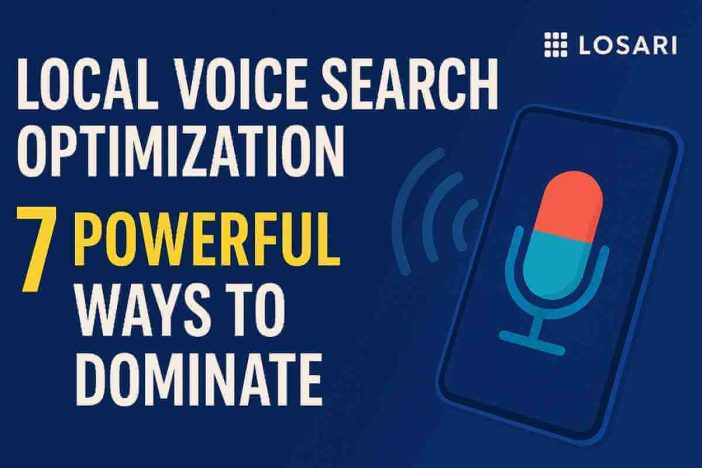
It was a damp Tuesday morning when the café owner heard her phone ping. A visitor had asked aloud, “Hey Google – what’s the best pastry shop near me that opens before eight?” And just like that, an entirely new kind of customer footfall began: someone speaking into thin air, and a small business answering. That moment—equal parts human, technological, and immediate—is the heart of Local Voice Search Optimization, a quiet revolution that’s already changing how people find you.
As the scent of freshly baked croissants drifted into the street, she realized: chances for discovery were no longer just about typed searches. They were about voice commands, local intent, conversational queries, and near-instant answers. And for smart marketers, that moment is a signal: adapt, or risk being unheard.
In today’s fast-moving digital landscape, mastering Local Voice Search Optimization isn’t a luxury—it’s essential. With voice assistants embedded in smartphones, smart speakers, and even cars, the way consumers ask questions has shifted dramatically. Short typed queries like “bakery London” have transformed into natural, conversational phrases such as “Which bakery in Bloomsbury is open now and has gluten-free options?” To win those customers, your content and listings must match that natural flow.
Why Local Voice Search Matters
Real-World Data You Can’t Ignore
- Over 58% of people use voice search to find local business information.
- About 76% of voice-search queries on smart speakers have local intent (“near me” queries) or involve local businesses.
- Voice search result pages tend to have around 2,300 words and load faster than standard pages.
- After a local voice search, 88% of smartphone users will visit or call a store within a day.
- The number of voice assistants in use worldwide has exceeded several billion, and it’s still growing.
What It Means for Your Business
When someone speaks, they often have immediate intent—they’re looking for a nearby service, quick answer, or immediate purchase. If your business isn’t optimized for spoken queries, you risk missing out on a huge group of ready-to-buy customers. By focusing on Local Voice Search Optimization, you place your brand exactly where intent meets action—where voice becomes conversion.
Local Voice Search Optimization
1. Understand the Unique Nature of Spoken Queries
When people type, they use short fragments. When they speak, they ask full, conversational questions—often including a location or urgency.
Key characteristics:
- Spoken queries frequently begin with words like who, what, where, why, and how.
- They are longer and more descriptive, often ranging from 20 to 30 words.
- They include strong local intent, such as “near me,” “open now,” or “in [city name].”
Actionable tips:
- Listen to how your customers talk. Identify common phrases and pain points.
- Create content that mirrors natural speech.
- Include headings and FAQs that answer conversational questions directly.
- Avoid robotic wording—keep your tone human and helpful.
Example:
A coffee shop in Jakarta could include an FAQ like:
“Which café in Kemang is open now and serves dairy-free lattes?”
That question mirrors how people naturally speak when using voice assistants.
2. Optimize Your Google Business Profile and Local Listings
For local voice searches, your Google Business Profile is often the deciding factor. Voice assistants rely heavily on structured business information when choosing what to present.
Best practices:
- Ensure your Name, Address, and Phone number (NAP) are consistent everywhere.
- Keep your business hours accurate, including special or holiday hours.
- Use specific categories and attributes like “pet friendly,” “wheelchair accessible,” or “outdoor seating.”
- Include concise business descriptions that answer spoken queries such as, “We’re a 24-hour coffee shop in Kemang serving vegan and dairy-free options.”
- Encourage customers to leave reviews, and respond to them regularly.
Why it matters:
Over 70% of local voice queries lead to physical visits. An accurate, active, and well-optimized profile directly increases visibility and credibility.
3. Target Conversational Long-Tail Queries
Since voice searches are more conversational, you need to align your content strategy with how people actually talk.
How to adapt:
- Focus on long-tail phrases and question-based queries.
- Include location modifiers such as “near me,” “open now,” or “in [neighborhood].”
- Answer questions briefly and directly in your content so that assistants can read them aloud.
- Create FAQ pages that mimic real speech patterns.
Example:
A plumber in Denver might include this question and answer on their website:
Q: “Where can I find an emergency plumber in Denver open late?”
A: “We provide 24-hour emergency plumbing across Denver with fast response times.”
This matches how customers phrase their requests aloud, improving your ranking in voice results.
4. Structure Content for Featured Snippets and Voice Answers
Nearly 40% of all voice-assistant answers come from Featured Snippets. To earn that spot, you must structure your content intentionally.
Tips for voice-friendly structure:
- Use H2 or H3 headers in the form of direct questions.
- Follow each header with a clear, 40–60-word answer.
- Expand with supporting details, examples, and data.
- Use bullet points or tables for clarity.
- Add structured data like FAQ schema and Local Business schema.
Example:
H2: What is Local Voice Search Optimization?
Answer:
Local voice search optimization means tailoring your content, website, and listings so voice assistants can accurately find and present your business when people ask spoken questions like “Where is the nearest 24-hour bakery near me?”
5. Improve Mobile Speed and Performance
Voice searches are primarily conducted on mobile devices and smart assistants, so speed and responsiveness are critical.
Key actions:
- Use responsive design so your site adjusts smoothly across devices.
- Aim for a load time under five seconds—faster pages rank better in voice search results.
- Use HTTPS for secure browsing.
- Compress large images, minimize JavaScript, and enable caching.
- Display the most important information above the fold for instant visibility.
Why it matters:
If someone asks, “Which restaurant near me is open now?” and your site takes too long to load, the assistant may skip it and pick another business instead.
When you’re focusing on Local Voice Search Optimization, having the right tool in your CMS can make a big difference. The “All In One SEO Pack plugin” is one such tool that sets the foundation for strong on-page architecture, meta tags, and site health — all of which support voice-search readiness.
6. Create Location-Based Content with “Near Me” Intent
Local intent is the backbone of Local Voice Search Optimization. People often ask for businesses or services in specific areas.
Action plan:
- Build city- or neighborhood-specific landing pages.
- Include addresses, maps, phone numbers, and photos.
- Naturally use phrases like “near [landmark],” “in [district],” or “close to [area].”
- Encourage local backlinks from community blogs or directories.
- Include authentic customer testimonials mentioning your area.
Example:
“Looking for a car wash near Kemang open 24/7? Our Sanur Street branch offers express cleaning and detailing anytime, day or night.”
Supporting data:
- 78% of local mobile searches lead to offline purchases.
- Local voice searches are increasing faster than text-based searches.
7. Monitor, Measure, and Continuously Improve
Local Voice Search Optimization isn’t a one-time setup—it’s an ongoing strategy that requires observation and refinement.
What to track:
- Which queries are bringing visitors to your site.
- How users engage with your Google Business listing (calls, directions, clicks).
- Rankings for both text and voice searches.
- Review performance and customer sentiment.
What to adjust:
- Update FAQs and business listings regularly.
- Keep your website mobile-friendly and fast.
- Add new local pages as you expand service areas.
- Optimize for seasonal or event-based voice queries (e.g., “Christmas brunch near me”).
To ensure your Local Voice Search Optimization strategy aligns with what search engines truly reward, it’s essential to understand how Google evaluates content quality and relevance. The official Google Search documentation provides clear insights into creating genuinely helpful, user-first pages that build long-term visibility and trust. Following these principles not only improves voice search performance but also strengthens your authority across all search results. You can explore the complete guide in Google’s official documentation to refine your approach based on verified best practices.
Common Mistakes to Avoid
- Overusing short phrases instead of conversational language.
- Ignoring local dialects or neighborhood references.
- Forgetting to use structured data and voice-friendly formatting.
- Neglecting mobile usability or speed performance.
- Leaving outdated information on listings.
Wrapping Up: Your Roadmap to Voice-Driven Success
Voice search isn’t just the future—it’s already shaping how people find local businesses today. By implementing Local Voice Search Optimization, you adapt your digital presence to match how real people speak and search.
To recap:
- Audit and update your local listings.
- Focus on natural, conversational queries.
- Structure your content for snippets and voice answers.
- Optimize for mobile speed and security.
- Build local content that truly connects with your community.
- Measure your performance and refine continually.
When you align your strategy with how people actually talk, you do more than just rank—you become their spoken answer. And that’s the real power of Local Voice Search Optimization.



